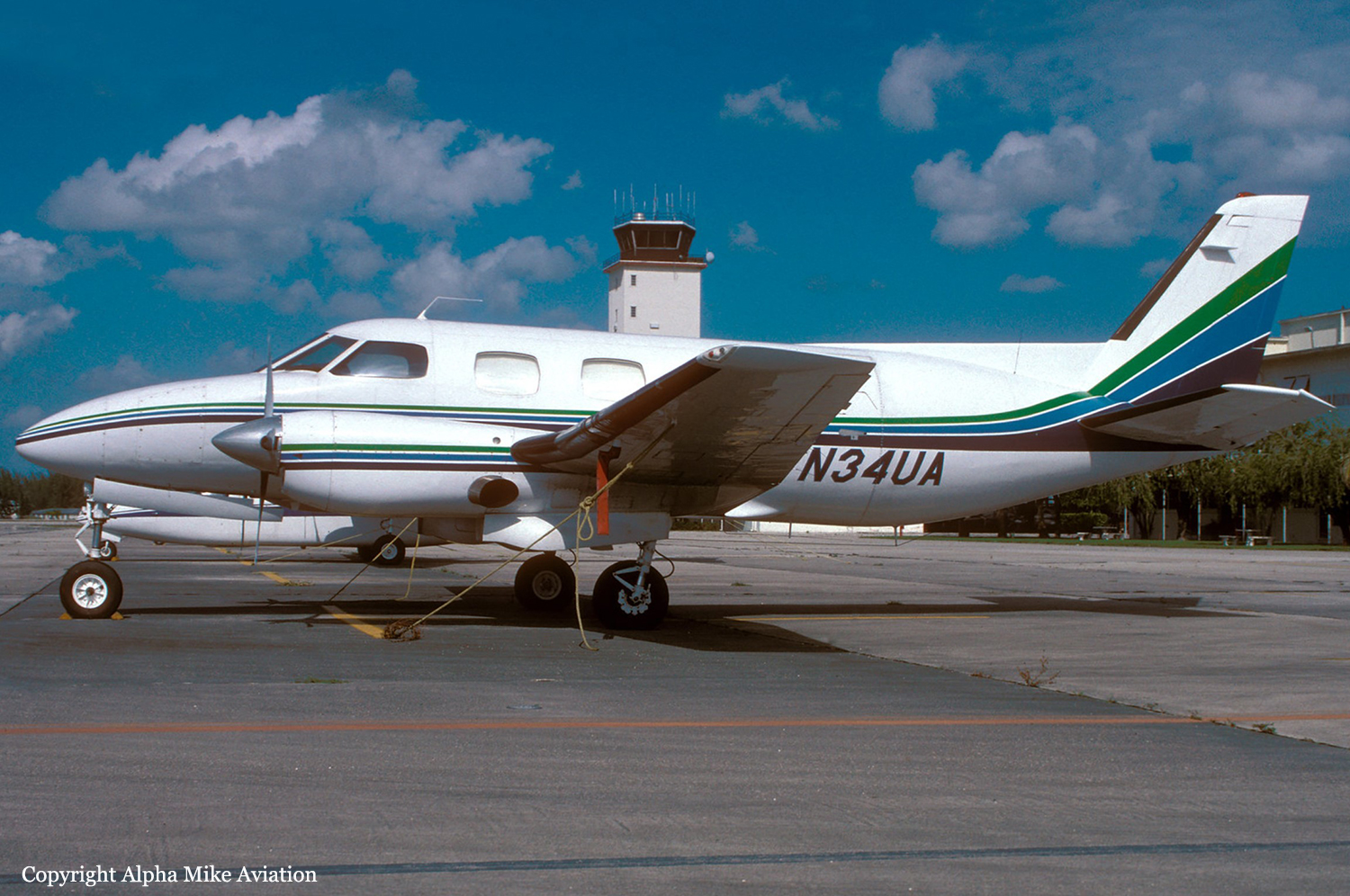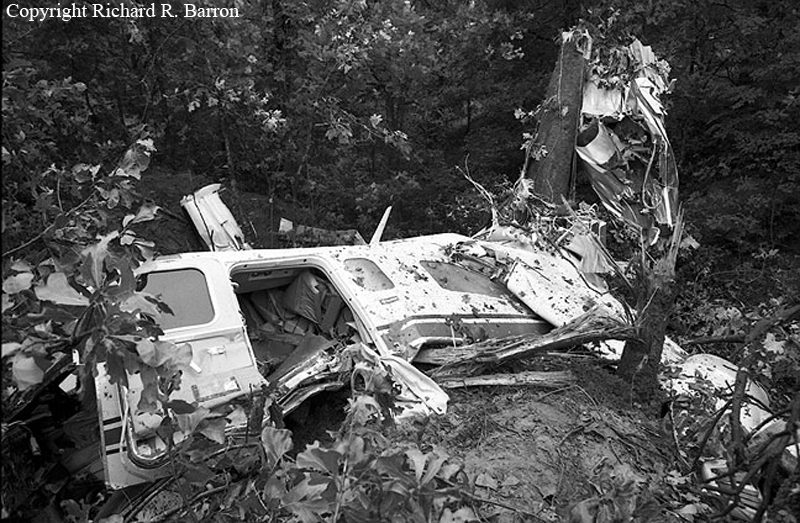Country
code
OK
Crash of a Piper PA-61 Aerostar (Ted Smith 601) in Oklahoma City: 2 killed
Date & Time:
Jul 23, 1999 at 1113 LT
Registration:
N345LS
Survivors:
No
Schedule:
Oklahoma City – San Angelo
MSN:
61-0315-085
YOM:
1976
Crew on board:
1
Crew fatalities:
Pax on board:
1
Pax fatalities:
Other fatalities:
Total fatalities:
2
Captain / Total hours on type:
100.00
Aircraft flight hours:
2945
Circumstances:
During takeoff, the twin-engine airplane was observed to roll left, pitch nose down, and impact terrain shortly after the pilot reported to ATC that he had a problem. Witnesses reported that the left engine was producing black smoke during the takeoff roll. One witness stated that the airplane had slowed to approximately 60-70 mph prior to rolling to the left. A mechanic, who worked on the airplane prior to the accident, stated that the pilot reported being unable to maintain manifold pressure (MP) with the left engine. The mechanic found that the left engine's rubber interconnect boot, which routes induction air between the turbocharger controller elbow and the fuel servo, was 'gaping open.' The mechanic reseated the boot and tightened the clamp. The pilot flew the airplane and reported no problems. During a second flight, the pilot reported that the left engine was again unable to maintain MP. Prior to the accident flight, the pilot informed the mechanic that the 'hose had slid off again' and that it had been reinstalled and he 'felt sure it was o.k.' A witness stated that he saw the pilot working on the left engine the morning of the accident. At the accident site, the left engine's interconnect boot was found disconnected. The clamp securing the boot was not located. No other preimpact anomalies were found with the engines, propellers, turbochargers, or fuel servos.
Probable cause:
The pilot's failure to maintain the minimum controllable airspeed. A factor was the disconnected rubber interconnect boot, which resulted in the partial loss of left engine power.
Final Report:
Crash of a Cessna 402C in Goldsby: 1 killed
Date & Time:
Apr 27, 1999 at 0916 LT
Registration:
N819BW
Survivors:
No
Schedule:
Dallas - Oklahoma City
MSN:
402C-0423
YOM:
1980
Flight number:
TXT818
Crew on board:
1
Crew fatalities:
Pax on board:
0
Pax fatalities:
Other fatalities:
Total fatalities:
1
Aircraft flight hours:
20457
Circumstances:
The twin-engine airplane impacted the ground in an uncontrolled descent following the inflight separation of the right wing during a normal descent. The airplane had accumulated a total time of 20,457 hours and had been flown 52 hours since the most recent annual inspection, which was performed by the current operator 3 weeks prior to the accident. Available maintenance records indicated that since 1988, maintenance personnel had made numerous repairs to the right wing, including repairing skin cracks, working rivets, wing stub spar straps, and the right main landing gear. Metallurgical examination revealed that the right wing's front spar failed due to fatigue that started at an area of mechanical damage and rough machining marks. The presence of primer covering the mechanical damage strongly suggests that the damage was produced during the manufacturing process. It could not be determined whether the mechanical damage or the machining, acting alone, could have caused the fatigue cracking to initiate. Fatigue cracking found on the rear spar and the forward auxiliary spar is most likely secondary fatigue due to load shedding as the crack grew in the front spar.
Probable cause:
The fatigue failure of the right wing spar as a result of inadequate quality control during manufacture of the spar. A factor was the inadequate inspection of the right wing by maintenance personnel, which failed to detect the crack.
Final Report:
Crash of a Cessna 421C Golden Eagle III near Cleveland: 6 killed
Date & Time:
Dec 21, 1995 at 1442 LT
Registration:
N421EP
Survivors:
No
Schedule:
Tulsa - Aspen
MSN:
421C-1236
YOM:
1982
Crew on board:
1
Crew fatalities:
Pax on board:
5
Pax fatalities:
Other fatalities:
Total fatalities:
6
Circumstances:
At 1350 cst, a McAlester FSS specialist gave a preflight briefing to a Cessna 421 pilot concerning IMC (instrument meteorological conditions) along the route & advised that VFR flight was not recommended. Cloud tops were at 12,000', & freezing level was at 1,600'. A PIREP at 1416 cst reported light mixed icing from 6,400' to 9,000' at Oklahoma City. At 1424 cst, the pilot departed Tulsa (VFR), then radar service was terminated. No further communication was received from the airplane. Radar data showed that it climbed westerly, reaching 9,800' at 1440 cst; during the next 88 seconds, its heading & altitude deviated until it descended through 3,200'. Ground witnesses saw the airplane descend out of low clouds in a 'flat spin' & crash. No preimpact mechanical failure was found. The airplane's gross weight was about 150 lbs over its maximum limit. In November 1995, the pilot received 10 hrs of Cessna 421 simulator training; his instructor noted in training records that he met minimum standards for VFR, but 'under IMC conditions,' he 'could not maintain altitude within 1,300 feet or heading within 40 degrees.' Postmortem toxicology tests showed 0.079 mcg/ml Nordiazepam (metabolite of Valium) in kidney fluid, 0.044 mcg/ml Desipramine (metabolite of Imipramine, an antidepressant) in spleen fluid, 0.733 mcg/ml Diphenhydramine (Benadryl) in spleen fluid, & 0.353 mcg/ml Diphenhydramine in lung fluid. These medications are not approved by the FAA for use while flying. The airplane was equipped for flight in icing & IFR
conditions.
conditions.
Probable cause:
The pilot's continued VFR flight into instrument meteorological conditions (IMC), and his failure to maintain control of the airplane after encountering adverse weather conditions, which resulted in a stall/spin. Factors relating to the accident were: pilot impairment due to a medication that was not approved by the FAA for use while flying, the adverse weather conditions, and the pilot's lack of instrument proficiency in the Cessna 421 airplane.
Final Report:
Crash of a Rockwell Grand Commander 690A in Guthrie: 2 killed
Date & Time:
Feb 12, 1995 at 1721 LT
Registration:
N69TM
Survivors:
No
Schedule:
Wichita - Oklahoma City
MSN:
690-11322
YOM:
1976
Crew on board:
1
Crew fatalities:
Pax on board:
1
Pax fatalities:
Other fatalities:
Total fatalities:
2
Circumstances:
The airplane impacted terrain approx 14 miles from the destination during a descent. According to radar data and meteorological information, the airplane descended from 16,700 feet to 3,700 feet agl through clouds and icing conditions. During the descent, the airplane decelerated from 268 kts to 92 kts ground speed. The pilot reported to approach that he 'broke out' of the clouds at 5,400 feet. He subsequently informed approach that he had accumulated 'some clear and rime ice' during the descent. 13 seconds later the pilot made a distress call and stated, 'we're in trouble, we're going down.' The last radar track showed the airplane descending through 3,700 feet at a ground speed of 92 kts. A witness reported he observed that the airplane 'appeared to be doing tricks', and 'then headed straight down in a spin.' An airmet for icing conditions was in effect along the airplane's route of flight. Also, there were several pilot reports of icing encountered in the area of the accident. The pilot did not request a weather briefing prior to, or during the flight.
Probable cause:
The pilot's failure to maintain adequate airspeed due to airframe ice, which resulted in a loss of control. Factors contributing to the accident were the pilot's continued flight into adverse weather, his failure to obtain weather information either before or during the flight, and the icing conditions.
Final Report:
Crash of a Swearingen SA26AT Merlin IIB in Ardmore
Date & Time:
Feb 10, 1993 at 1645 LT
Registration:
N34UA
Survivors:
Yes
Schedule:
Lindale - Ardmore
MSN:
T26-145
YOM:
1969
Crew on board:
1
Crew fatalities:
Pax on board:
0
Pax fatalities:
Other fatalities:
Total fatalities:
0
Captain / Total hours on type:
25.00
Circumstances:
During a missed approach the airplane lost power to both engines. The pilot selected the only area available to land. The terrain was marked by trees, fences, and rising terrain. Prior to the missed approach the airplane had landed at another airport in the same town. The purpose of the flight was to ferry the airplane to a facility to repair a fuel leak in the wing.
Probable cause:
Pilot's failure to refuel and fuel exhaustion. Factors were a fuel leak in the wing and unsuitable terrain.
Final Report:

Crash of a Rockwell Grand Commander 690B in Konawa: 1 killed
Date & Time:
Jun 25, 1992 at 0833 LT
Registration:
N690JC
Survivors:
No
Schedule:
Norman - Fort Lauderdale
MSN:
690-11479
YOM:
1978
Crew on board:
1
Crew fatalities:
Pax on board:
0
Pax fatalities:
Other fatalities:
Total fatalities:
1
Captain / Total hours on type:
98.00
Aircraft flight hours:
3355
Circumstances:
As the airplane was deviating around low intensity weather returns, and passing through 20,500 feet during climb out, it departed controlled flight and entered a right spiral. Descent rates exceeded 16,600 fpm during the descent from 18,300 feet to 3,900 feet and then slowed. Witnesses stated they saw the airplane descend from the clouds in a right flap spin. The empennage had separated from the airplane in pieces. Pieces of the wreckage were found up to 1.5 mile from the primary impact point. Both wings remained attached. The right engine was flamed out, and the propeller was feathered at impact. No mechanical reason for the flameout could be determined. At no time did the pilot indicate he was having difficulties. The NTSB weather study indicated that moderate turbulence was present in the area. The pilot's toxicology tests found 0.151 ug/ml of chlorpheniramine in the blood; normal therapeutic concentration is 0.01 to 0.04. Effects of overdosage include sedation, diminished mental alertness, and cardiovascular collapse to stimulation. The pilot, sole on board, was killed.
Probable cause:
The pilot's failure to maintain control of the airplane which resulted in an inadvertent spiral and subsequent rapid descent. The design stress limits of the airframe were exceeded resulting in an overload failure of the empennage. Factors related to the accident were: turbulence and the pilot's physical impairment due to drugs.
Final Report:

